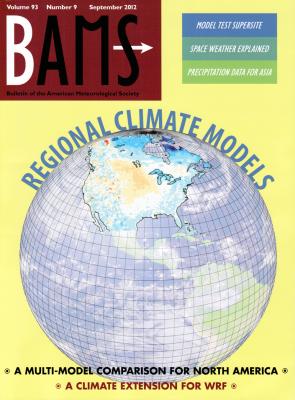Getting Collaborative About Climate: International Climate Research Team Finds Working Together Yields Best Results
An international group of researchers, including DOE's Pacific Northwest National Laboratory scientists Dr. L. Ruby Leung and Dr. Yun Qian, constructed a systematic examination of regional-scale climate models and their projections for North America. Using a multi-model ensemble approach, they compared physical climate process models on a regional scale to precipitation and temperature observational data. The controlled baseline data showed that working together, the ensemble results mostly outperformed any single model. The work was featured in the cover story of the October issue of the Bulletin of the American Meteorological Society.
The researchers organized the North American Regional Climate Change Assessment Program (NARCCAP) to evaluate temperature and precipitation results from six regional climate models over 1980–2004. For the first time in model assessments over North America, the international team adopted metrics to evaluate specific features of different models. Establishing common protocols in a controlled set of experiments, they came up with a baseline to compare each model's results. Their comparison showed that while no single model stood out, working in ensemble the models often returned the best results compared to observational data. The NARCCAP effort provided a unique opportunity to systematically compare and evaluate North American regional model data.
In the science of climate change, the prediction tool for the future is the climate model, complex computational representations of climate processes such as precipitation and temperature. Like comparing different automobile brands, each climate model may shine for one feature or another and have differing performance measures. To level the playing field in evaluating model outcomes, an international group of researchers collaborated to find a systematic way to evaluate the models’ performance. Their results show that working in ensemble may yield better results than any single model alone. Their findings will be important to regional resource managers planning for the future.
An international group of researchers, including DOE scientists at Pacific Northwest National Laboratory, constructed a systematic examination of regional-scale climate models and their projections for North America. Using a multi-model ensemble approach, they compared the results of physical climate process models on a regional scale to precipitation and temperature observational data. The controlled baseline data showed that working together the ensemble results mostly outperformed any single model. The researchers organized the North American Regional Climate Change Assessment Program (NARCCAP) to evaluate temperature and precipitation results from six regional climate models over 1980–2004. For the first time in model assessments over North America, the international team adopted metrics to evaluate specific features of different models. Establishing common protocols in a controlled set of experiments, they came up with a baseline to compare each model's results. Their comparison showed that while no single model stood out, working in ensemble the models often returned the best results compared to observational data. The NARCCAP effort provided a unique opportunity to systematically compare and evaluate North American regional model data. The work was featured in the cover story of the October issue of the Bulletin of the American Meteorological Society.
The U.S. Environmental Protection Agency Office of Research and Development, the National Oceanic and Atmospheric Administration, National Science Foundation, and the U.S. Department of Energy, Office of Science, Biological and Environmental Research, Regional Global Climate Modeling program. The work was performed by L. Mearns, S. Bukovsky, S. McGinnis, S. Sain, and L. McDaniel, National Center for Atmospheric Research; R. Arritt, D. Flory, W. Gutowsky, and E.S. Takle, Iowa State University; S. Biner and D. Caya, Ouranos, Montreal, Quebec, Canada; J. Correia, L. Ruby Leung, and Yun Qian, PNNL; R. Jones and W. Moufouma-Okia, Hadley Centre; A.M.B. Nunes, Universidade Federal do Rio de Janeiro, and Scripps Institution of Oceanography; J. Roads, Scripps Institution of Oceanography; L. Sloan and M. Snyder, University of California, Santa Cruz.

